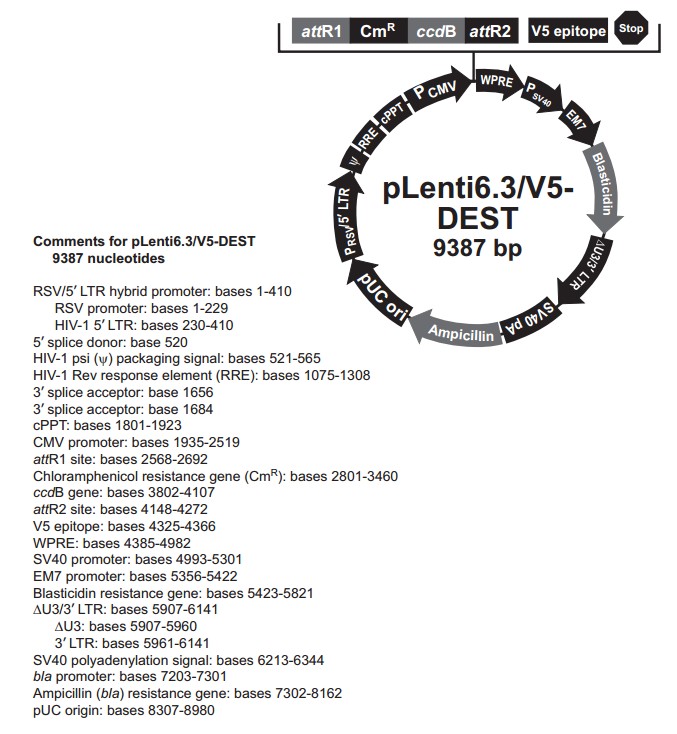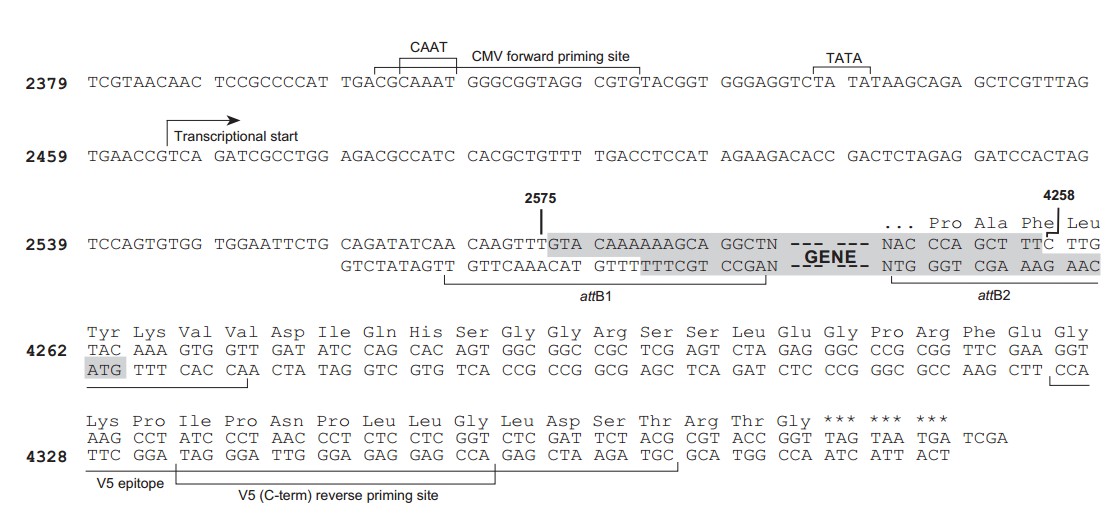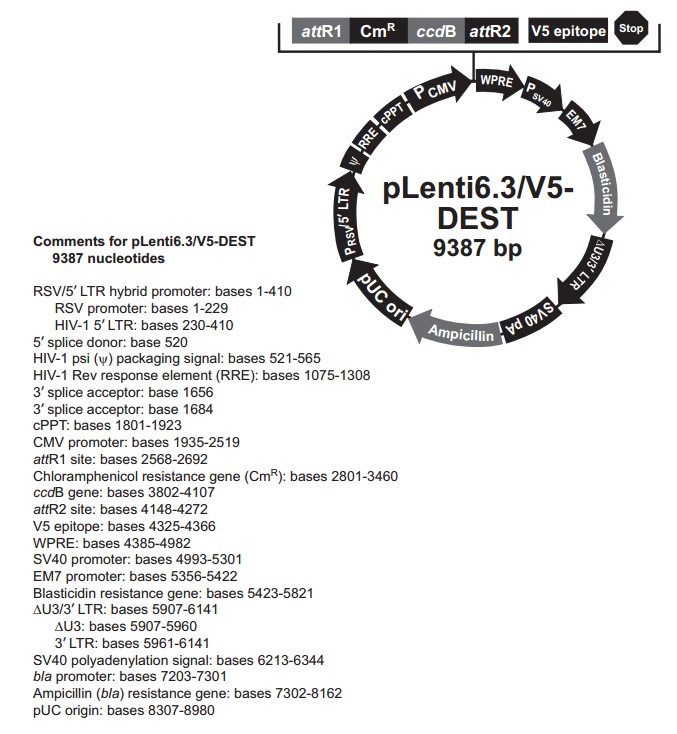pLenti6.3-V5-DEST
pLenti6.3-V5-DEST
编号 | 载体名称 |
北京华越洋VECT511178 | pLenti6.3-V5-DEST |
pLenti6.3-V5-DEST Gateway载体基本信息:
载体名称: | pLenti6.3-V5-DEST |
质粒类型: | 慢病毒表达载体;Gateway系统载体 |
高拷贝/低拷贝: | 高拷贝 |
启动子: | CMV |
克隆方法: | Gateway |
载体大小: | 9387 bp |
5' 测序引物及序列: | CMV-F:CGCAAATGGGCGGTAGGCGTG |
3' 测序引物及序列: | WPRE-R:CATAGCGTAAAAGGAGCAACA |
载体标签: | V5 Epitope Tag (C-端) |
载体抗性: | 氨苄青霉素,氯霉素(仅空载体) |
筛选标记: | Blasticidin |
克隆菌株: | DB3.1 |
宿主细胞(系): | 常规细胞系,293、CV-1、CHO等 |
备注: | pLenti6.3-V5-DEST载体是pLenti6/V5-DEST的升级版本。 |
稳定性: | 稳表达 |
组成型: | 组成型 |
病毒/非病毒: | 慢病毒 |
pLenti6.3-V5-DEST载体质粒图谱和多克隆位点信息:


pLenti6.3-V5-DEST载体简介:
pLenti6.3-V5-DEST载体描述
Invitrogen's pLenti6.3-V5-DEST Gateway Vector Kit is part of our ViraPower HiPerform Lentiviral Gateway Expression Kit .
The pLenti6.3⁄V5-DEST Gateway Vector Kit contains the Gateway-adapted ViraPower HiPerform lentiviral expression vector, pLenti6.3⁄V5-DEST for easy recombination-based cloning and high-level expression of a target gene in dividing and non-dividing mammalian cells. The pLenti6.3⁄V5-DEST vector is equipped with two key genetic elements, making it a HiPerform vector: the Woodchuck Posttranscriptional Regulatory Element (WPRE) and the central Polypurine Tract (cPPT) sequence from the HIV-1 integrase gene to produce at least 4-fold increase in protein expression compared to vectors lacking these elements.
pLenti6.3-V5-DEST载体优点
• Stable expression
• Long-term experiments
• Accurate titer of functional virus
• Flexible and versatile Gateway® recombination cloning technology
pLenti6.3-V5-DEST载体特征
• HiPerform™ WPRE and cPPT elements
• CMV promoter
• V5 epitope tag at C terminus
• Blasticidin selection
Gateway技术
The Gateway Technology is a universal cloning method that takes advantage of the site-specific recombination properties of bacteriophage lambda (Landy, 1989) to provide a rapid and highly efficient way to move your gene of interest into multiple vector systems. To express your gene of interest using
Gateway Technology, simply:
1. Generate entry clones containing your promoter and gene(s) of interest.
2. Generate an expression clone by performing an LR recombination reaction between the entry clone(s) and pLenti6.3-V5-DEST).
3. Transfect your expression clone into cells of your choice to transiently or stably express your gene of interest.
To fit all of your expression needs, Invitrogen offers state-of-the-art Gateway destination vectors for expression in E. coli, insect, yeast, or mammalian cells, as well as for production of native protein or N- or C-terminal fusion proteins. All Gateway destination vectors have attR sites for recombination with any attL-flanked fragment, regardless of whether it is an entry clone or an Ultimate ORF Clone. The following table lists a variety of available destination vectors.
Additional materials required, available separately: Gateway entry clone, appropriate Gateway LR Clonase enzyme mix, and reaction buffer.
所需材料
在着手开始实验前你需要准备一下材料:
Gateway entry clone, appropriate Gateway LR Clonase enzyme mix, and reaction buffer.
• Purified plasmid DNA of your entry clone(s) (10 fmoles each)
• pLenti6.3-V5-DEST (20 fmoles)
• LR Clonase II Plus enzyme mix (keep at –20°C until immediately before use)
• 1X TE Buffer, pH 8.0 (10 mM Tris-HCl, pH 8.0, 1 mM EDTA)
• 2 μg/μL Proteinase K solution (supplied with the enzyme mix; thaw and keep on ice until use)
• Appropriate competent E. coli host and growth media for expression
• S.O.C. Medium
• LB agar plates containing 100 μg/mL ampicillin
进行LR重组反应
值得注意的事项:
If you use E. coli cells with a transformation efficiency of ≥1 × 108 cfu/μg, a typical LR reaction should give >5,000 colonies if the entire reaction is transformed and plated.
For multiple fragment reactions, typical numbers of colonies (per 10 μL LR reaction) are:
• 2-fragment recombination reaction: 2,000–15,000
• 3-fragment recombination reaction: 1,000–5,000
• 4-fragment recombination reaction: 50–500
Confirming the Expression Clone
The ccdB gene mutates at a very low frequency, resulting in a very low number of false positives. True expression clones will be ampicillin-resistant and chloramphenicol-sensitive. Transformants containing a plasmid with a mutated ccdB gene will be both ampicillin- and chloramphenicol-resistant.
To check your putative expression clone, test for growth on LB plates containing 30 μg/mL chloramphenicol. A true expression clone will not grow in the presence of chloramphenicol.
Sequencing To confirm that your gene of interest is in frame with the C-terminal V5 epitope, you may sequence your expression construct, if desired. We suggest using the following primer sequences.
pLenti6.3-V5-DEST载体序列
pLenti6.3-V5-DEST其他相关Gateway载体:


